Balbharti Maharashtra State Board Class 12 History Important Questions Chapter 7 Decolonisation to Political Integration of India Important Questions and Answers.
Maharashtra State Board 12th History Important Questions Chapter 7 Decolonisation to Political Integration of India
1A. Choose the correct alternative and rewrite the statement.
Question 1.
Decolonisation is the process of ending the colonial rule and handing over __________ to local people by colonialists.
(a) The political and administrative power
(b) The political and social power
(c) The social and cultural power
(d) The social and economical power
Answer:
(a) The political and administrative power
Question 2.
__________ handled the situation with great skill and tact.
(a) Sardar Vallabhbhai Patel
(b) Maulana Abdul Kalam Azad
(c) Pandit Jawaharlal Nehru
(d) Dr. T.B. Kunha
Answer:
(a) Sardar Vallabhbhai Patel
![]()
Question 3.
In February 1948, __________ merged in India.
(a) Junagadh
(b) Dadra and Nagar Haveli
(c) Hyderabad
(d) Kashmir
Answer:
(a) Junagadh
Question 4.
In __________ people wanted to merge in India and the Nawab wanted to merge in Pakistan.
(a) Saurashtra
(b) Kashmir
(c) Hyderabad
(d) Rajasthan
Answer:
(a) Saurashtra
Question 5.
The __________ passed a resolution in favour of Hyderabad’s merger in India.
(a) Hyderabad State Congress
(b) Marathwada Parishad
(c) Karnataka Parishad
(d) Andhra Parishad
Answer:
(a) Hyderabad State Congress
Question 6.
17th September 1948 the day of Hyderabad’s freedom is celebrated as the __________
(a) Marathwada Liberation Day
(b) Hyderabad Liberation Day
(c) Marathwada Labour Day
(d) Hyderabad Day
Answer:
(a) Marathwada Liberation Day
![]()
Question 7.
__________ was started by the Indian Army in Goa to free from the Portuguese.
(a) Operation Vijay
(b) Operation Thunder
(c) Operation Blue Star
(d) Operation Anti-Portuguese
Answer:
(a) Operation Vijay
Question 8.
According to __________ Jammu and Kashmir got special status.
(a) Article 370
(b) Article 470
(c) Article 315
(d) Article 365
Answer:
(a) Article 370
Question 9.
In 1939, posters with __________ slogans were posted all over Goa.
(a) Quit Goa
(b) Quit Portuguese
(c) Quit India
(d) Non-Cooperation Movement
Answer:
(a) Quit Goa
1B. Find the incorrect pair from group ‘B’ and write the corrected one.
Question 1.
| Group ‘A’ | Group ‘B’ |
| (a) Hyderabad’s Organisation | Hyderabad State Congress |
| (b) Goa’s Organisation | Goa Congress Committee |
| (c) Puducherry Leader | Dr. T.B. Kunha |
| (d) Kashmir’s King | King Hari Singh |
Answer:
Puducherry Leader – Subbayya
Question 2.
| Group ‘A’ | Group ‘B’ |
| (a) Junagadh merged in India | February 1948 |
| (b) Hyderabad merged in India | September 1948 |
| (c) Dadra and Nagar Haveli merged in India | August 1955 |
| (d) Goa became part of India | December 1961 |
Answer:
Dadra and Nagar Haveli merged in India – August 1954
Question 3.
| Group ‘A’ | Group ‘B’ |
| (a) Sardar Patel | 1st Prime Minister |
| (b) Swami Ramanand Tirth | Hyderabad Freedom Struggle |
| (c) Francis Mascarenhas | United Goan Front |
| (d) Keshavrao Jedhe | Goa Vimochan Sahayak Samiti |
Answer:
Sardar Patel – Deputy Prime Minister
![]()
Question 4.
| Group ‘A’ | Group ‘B’ |
| (a) Junagadh | February 1948 merged in India |
| (b) Hyderabad | September 1948 merged in India |
| (c) Dadra and Nagar Haveli | In 1961 Union Territory |
| (d) Jammu and Kashmir | Article 470 |
Answer:
Jammu and Kashmir – Article 370
2A. Write the names of historical places/persons/events.
Question 1.
Languages were spoken in Hyderabad –
Answer:
Telugu, Kannada, and Marathi
Question 2.
Various organisations in Hyderabad –
Answer:
Andhra Parishad, Maharashtra Parishad, and Karnataka Parishad
Question 3.
Head of the Razakar Organisation –
Answer:
Kasim Razvi
Question 4.
Name of the mission planned by the Indian Army in Goa –
Answer:
Operation Vijay
Question 5.
People of Puducherry got united under the leadership of –
Answer:
Subbayya
![]()
Question 6.
Name of the regions controlled by the French –
Answer:
Puducherry, Karaikal, Maho, Yanam, and Chandranagar
2B. Choose the correct reason from those given below and complete the sentence.
Question 1.
Junagadh merged in India because __________
(a) Nawab wanted to merge in Pakistan
(b) People of Junagadh wanted to merge in India
(c) People of Junagadh opposed Nawab’s decision
(d) All of above
Answer:
(d) All of above
Question 2.
Nizam had opposed the resolution passed by Hyderabad State Congress because __________
(a) He was willing to join Pakistan
(b) Fear of losing his hold over Hyderabad
(c) people were in favour of India
(d) All of above
Answer:
(d) All of above
Question 3.
Pakistan attacked on Kashmir because __________
(a) Pakistan wanted to capture Kashmir
(b) King Hari Singh wanted to join India
(c) People of Kashmir wanted to join India
(d) King Hari Singh neither wanted to join Pakistan nor India
Answer:
(a) Pakistan wanted to capture Kashmir
3A. Observe the map on textbook page 61 and answer the questions based on it.
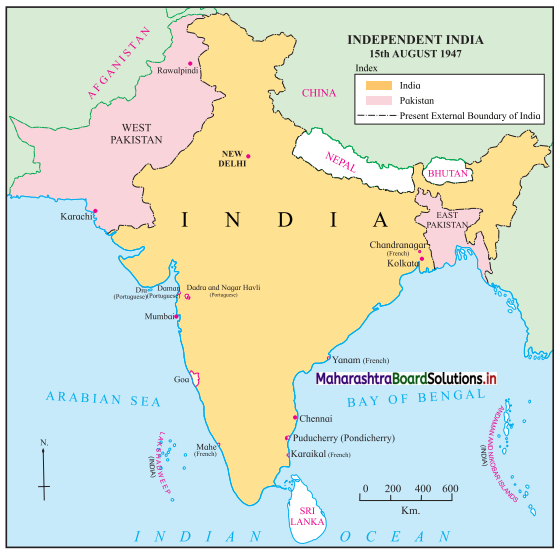
Question 1.
Name the countries located at the northeast border of India.
Answer:
China, Nepal, Bhutan, and East Pakistan.
Question 2.
What is the theme of the map?
Answer:
Independent India, 15th August 1947.
![]()
Question 3.
Name of the island located nearby India.
Answer:
Andaman and Nicobar island.
Question 4.
Name of the regions located on the western coast of India.
Answer:
Diu, Daman, Mumbai, Goa, and Mahe.
Question 5.
Name of the regions located on the eastern coast of India.
Answer:
Kolkata, Yanam, Chennai, Puducherry, and Karaikal.
3B. Complete the following concept map.
Question 1.
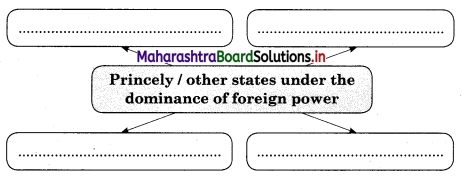
Answer:
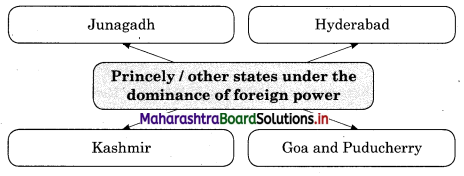
Question 2.
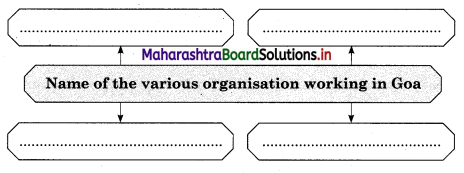
Answer:
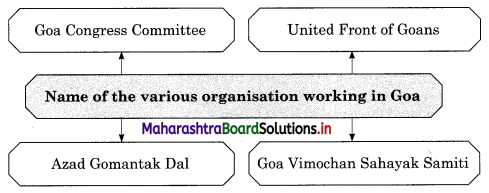
Question 3.
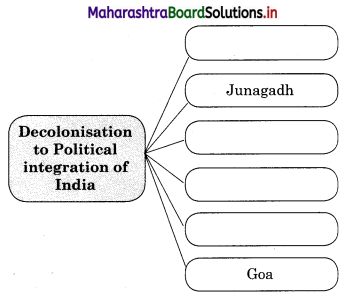
Answer:
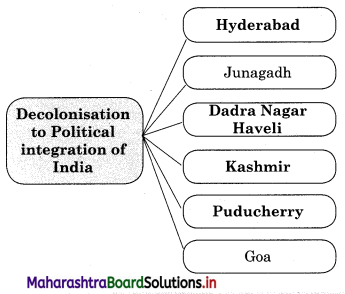
4A. Write short notes.
Question 1.
Junagadh
Answer:
- Junagadh was located in Gujarat.
- Nawab of Junagadh was planning to merge the state into Pakistan, but the people of Junagadh were in favour of India.
- After getting the people against him, he flew to Pakistan, in February 1948 Junagadh became part of Independent India.
Question 2.
Kashmir merged in India
Answer:
- After declaring British Policy regarding princely states, King Hari Sigh of Kashmir neither wanted to join Pakistan nor India.
- But Pakistan wanted to capture Kashmir.
- Soon Pakistan attacked Kashmir, King Hari Singh sought help from Pandit Jawaharlal Nehru.
- Indian army had already started recapturing parts of the land which had been captured by the Pakistani army.
- Meanwhile, UNO intervened in this matter and Pakistan and India had to stop the war. But by this decision, some parts of Kashmir remained occupied by Pakistan.
- Later on, King Hari Singh was ready to merge in India. Special provisions were passed and through this Kashmir got special status under Article 370.
![]()
Question 3.
Dadra and Nagar Haveli
Answer:
- Dadra and Nagar Haveli is located in Gujarat, near the Damanganga river, it was under the control of the Portuguese.
- Like other regions of India, the people of Dadra and Nagar Haveli also got freedom from the Portuguese.
- Many organisations like the United Front of Goans and Azad Gomantak Dal came together to fight against the Portuguese reign.
- These organisations and their branches started capturing the area under it. Many police stations and administration offices were attacked.
- The Portuguese army was called to control people. At the same time, the Government of India appointed Governor and signed the agreement.
- According to this treaty, Dadra and Nagar Haveli merged in India on 2nd August 1954 and in 1961, got status of ‘Union Territories.’
Question 4.
Puducherry
Answer:
- Similar to Dadra and Nagar Haveli, Puducherry was under French rule.
- Most of the east coast of India regions like Puducherry, Karaikal, Mahe, Yanam, and Chandrangar in West Bengal were under French rule as well.
- People and many political parties under the leadership of V. Subbayya came together to get rid of the French.
- It was a serious matter for the Government of India; hence they demanded that French Government return the Indian regions. In 1948, an agreement was signed by both governments for Puducherry
- In 1949, Chandranagar was merged in India.
- In 1954, the French government passed the draft, according to it all French ruling regions will merge in India. And in 1963 Puducherry was declared a ‘Union Territory’.
Question 5.
Goa
Answer:
- Goa was under Portuguese control. In 1928 ‘Goa Congress Committee was formed and it became the branch of the Indian National Congress.
- ‘Quit Goa’ slogans were posted all over Goa.
- Dr. Kunha played an important role in Goa. Dr. Lohia got arrested in Civil Disobedience Movement.
- Dr. Kunha was also arrested. After his release from jail, he started a newspaper namely ‘Azad Goa’ and ‘Swatantra Goa’.
- One of the groups of activists unfurled the Indian flag at the fort of Panaji.
- Many eminent people participated in Goa Liberation Movement. Mohan Ranade systematically began anti-Portuguese propaganda in Goa. He was arrested and kept in jail till 1972.
- ‘Maratha’, a newspaper, was trying to get support from Maharashtra for Goa. Soon Pandit Jawaharlal Nehru sent the Indian army to Goa for the mission called “Operation Vijay”.
- Within 48 hours Portuguese surrendered and Goa became a part of the Indian Republic. And 450 years rule of foreign power came to an end.
4B. Explain the following statements with reasons.
Question 1.
Kashmir got special Status under Article 370.
Answer:
- From the beginning, Kashmir received special attention from all.
- After British policy for the princely states, Kashmir King Hari Singh decided not to be a part of Pakistan and also not to be a part of India.
- However, when Pakistan Pakistan attacked Kashmir, King Hari Singh asked India to help and he consented to merge Kashmir in India and officially submitted an agreement.
- Indian Army was sent to save Kashmir.
- Later on, the constitution of Jammu and Kashmir was drafted and it became part of India and got special status under ‘Article 370.’
![]()
Question 2.
‘Operation Vijay’ was planned in Goa.
Answer:
- Goa was under Portuguese control. In 1928 ‘Goa Congress Committee was formed and it became the branch of the Indian National Congress.
- ‘Quit Goa’ slogans were posted all over Goa.
- Dr. Kunha played an important role in Goa. Dr. Lohia got arrested in Civil Disobedience Movement.
- Dr. Kunha was also arrested. After his release from jail, he started a newspaper namely ‘Azad Goa’ and ‘Swatantra Goa’.
- One of the groups of activists unfurled the Indian flag at the fort of Panaji.
- Many eminent people participated in Goa Liberation Movement. Mohan Ranade systematically began anti-Portuguese propaganda in Goa. He was arrested and kept in jail till 1972.
- ‘Maratha’, a newspaper, was trying to get support from Maharashtra for Goa. Soon Pandit Jawaharlal Nehru sent the Indian army to Goa for the mission called “Operation Vijay”.
- Within 48 hours Portuguese surrendered and Goa became a part of the Indian Republic. And 450 years rule of foreign power came to an end.
Question 3.
Dadra and Nagar Haveli were declared Union territories.
Answer:
- Dadra and Nagar Haveli is located in Gujarat, near the Damanganga river, it was under the control of the Portuguese.
- Like other regions of India, the people of Dadra and Nagar Haveli also got freedom from the Portuguese.
- Many organisations like the United Front of Goans and Azad Gomantak Dal came together to fight against the Portuguese reign.
- These organisations and their branches started capturing the area under it. Many police stations and administration offices were attacked.
- The Portuguese army was called to control people. At the same time, the Government of India appointed Governor and signed the agreement.
- According to this treaty, Dadra and Nagar Haveli merged in India on 2nd August 1954 and in 1961, got status of ‘Union Territories.’
5. State your opinion.
Question 1.
‘Operation Polo’ was started in Hyderabad.
Answer:
- Swami Ramanand Tirth with loyal workers was leading a political organization to free Hyderabad from the Nizam.
- Hyderabad State Congress passed a resolution that Hyderabad will merge in India and this was not liked by Nizam, he was willing to join Pakistan.
- People of Hyderabad however, wanted to merge with India. Kasim Razvi formed the ‘Razakar’ organisation against people who were fighting for democracy.
- In the end Indian Government launched a police campaign against Nizam, called ‘Operation Polo’.
![]()
Question 2.
The Indian Army was sent for Kashmir’s Protection.
Answer:
- Kashmir King Hari Singh decided not to be a part of Pakistan and also not to be a part of India.
- However, when Pakistan attacked Kashmir, King Hari Singh asked India to help and he consented to merge Kashmir in India and officially submitted an agreement.
- Indian Army was sent to save Kashmir.
Question 3.
Dadra and Nagar Haveli got status of Union Territory.
Answer:
- Dadra and Nagar Haveli is located in Gujarat, near the Damanganga river, it was under the control of the Portuguese.
- Like other regions of India, the people of Dadra and Nagar Haveli also got freedom from the Portuguese.
- Many organisations like the United Front of Goans and Azad Gomantak Dal came together to fight against the Portuguese reign.
- These organisations and their branches started capturing the area under it. Many police stations and administration offices were attacked.
- The Portuguese army was called to control people. At the same time, the Government of India appointed Governor and signed the agreement.
- According to this treaty, Dadra and Nagar Haveli merged in India on 2nd August 1954 and in 1961, got status of ‘Union Territories.’
Question 4.
Contribution of Dr. Lohia and Dr. T.B. Kunha in Goa’s Freedom Struggle.
Answer:
- Dr. Ram Manohar Lohia started a movement called Civil Disobedience.
- Dr. Lohia and Dr. T.B. Kunha were arrested and sent to jail.
- Dr. Kunha was sent to Portugal for 8 years imprisonment.
- After returning to India he started the newspapers, ‘Azad Goa’ and ‘Swatantra Goa’.
- Both these leaders have contributed a lot to the freedom of Goa.
6. Answer the following questions in detail.
Question 1.
(a) Hyderabad Freedom Struggle
(b) The Kashmir Issue
(c) Dadra and Nagar Haveli
(d) Goa
(e) Puducherry
Answer:
(a) Hyderabad Freedom Struggle:
Hyderabad was under Nizam rule, it was one of the largest amongst princely states along with Telugu, Kannada, and Marathi regional sections. Various organisations were formed to fight against Nizam’s policy for their people.
![]()
- Nizam’s decision: Nizam was ruler and wanted to merge Hyderabad into Pakistan. The people of Hyderabad wanted democracy. It was not about one regional section. He put restrictions on the Civil and Political rights of his subjects to a great extent.
- Organisations: To fight against the suppressive policy of Nizam people of the state started various organisations namely Andhra Parishad in Telangana, Maharashtra Parishad in Marathwada, and Karnataka Parishad in Karnataka. Swami Ramananda Tirth formed an organisation with loyal workers called Hyderabad State Congress and gave direction for freedom.
- Operation Polo: People of Hyderabad wanted to merge in India. Kasim Razvi formed a ‘Razakar’ organisation against people. In the end, the Indian Government launched a police campaign against Nizam, called ‘Operation Polo’. In 1948 Nizam surrendered and Hyderabad merged in India.
(b) The Kashmir Issue:
From the beginning, Kashmir is special attention for all. After British policy for the princely states, Kashmir king Hari Singh decided not to be a part of Pakistan and also not be a part of India.
But Pakistan attacked Kashmir and King Hari Singh asked India to help and he consented to merge Kashmir in India and officially submitted an agreement. Indian Army was sent to save Kashmir. Later on, the constitution of Jammu and Kashmir was drafted and it became part of India and got special status under article 370.’
The intervention of UNO: In 1948, Pandit Jawaharlal Nehru took this matter to UNO. It became an international issue. Even UNO could not persuade Pakistan to withdraw their troops from the territory of Kashmir occupied by them. However, then the National Conference Party decided on a plebiscite to solve the issue and to accede Kashmir to India.
(c) Dadra and Nagar Haveli:
- Dadra and Nagar Haveli is located in Gujarat, near the Damanganga river, it was under the control of the Portuguese.
- Like other regions of India, the people of Dadra and Nagar Haveli also got freedom from the Portuguese.
- Many organisations like the United Front of Goans and Azad Gomantak Dal came together to fight against the Portuguese reign.
- These organisations and their branches started capturing the area under it. Many police stations and administration offices were attacked.
- The Portuguese army was called to control people. At the same time, the Government of India appointed Governor and signed the agreement.
- According to this treaty, Dadra and Nagar Haveli merged in India on 2nd August 1954 and in 1961, got status of ‘Union Territories.’
![]()
(d) Goa:
- Goa was under Portuguese control. In 1928 ‘Goa Congress Committee was formed and it became the branch of the Indian National Congress.
- ‘Quit Goa’ slogans were posted all over Goa.
- Dr. Kunha played an important role in Goa. Dr. Lohia got arrested in Civil Disobedience Movement.
- Dr. Kunha was also arrested. After his release from jail, he started a newspaper namely ‘Azad Goa’ and ‘Swatantra Goa’.
- One of the groups of activists unfurled the Indian flag at the fort of Panaji.
- Many eminent people participated in Goa Liberation Movement. Mohan Ranade systematically began anti-Portuguese propaganda in Goa. He was arrested and kept in jail till 1972.
- ‘Maratha’, a newspaper, was trying to get support from Maharashtra for Goa. Soon Pandit Jawaharlal Nehru sent the Indian army to Goa for the mission called “Operation Vijay”.
- Within 48 hours Portuguese surrendered and Goa became a part of the Indian Republic. And 450 years rule of foreign power came to an end.
(e) Puducherry:
- Similar to Dadra and Nagar Haveli, Puducherry was under French rule.
- Most of the east coast of India regions like Puducherry, Karaikal, Mahe, Yanam, and Chandrangar in West Bengal were under French rule as well.
- People and many political parties under the leadership of V. Subbayya came together to get rid of the French.
- It was a serious matter for the Government of India; hence they demanded that French Government return the Indian regions. In 1948, an agreement was signed by both governments for Puducherry
- In 1949, Chandranagar was merged in India.
- In 1954, the French government passed the draft, according to it all French ruling regions will merge in India. And in 1963 Puducherry was declared a ‘Union Territory’.